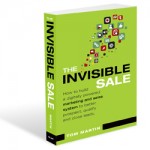Every day I talk to sales and marketing executives that lament their inability to convince their company to adopt social selling, inbound marketing and content marketing strategies and tactics. In fact I’ve gotten this question so many times that today I want to share with you the advice I give each of them. It’s a simple 6-step process that is easy enough to understand but surprisingly difficult to implement.
Step 1 – Stop Asking for Permission to Use Social Selling
Instead ask for forgiveness if the need arises. So many of the social selling tips and techniques I’ve shared with you on this blog can be used by you today. Lead by example. Create micro-case studies that show how effective the techniques are and then string those together to create your case. This step scares the hell out of people because they’re convinced they’ll be fired for trying. Honestly, if you’re really a good employee, will your company fire you for trying something that you believe will make the company more money? Or will they just issue a stern reprimand?
Step 2 – Find The Believers
There is strength in numbers. Go find others in your company that believe as you do. Form a group that meets either physically or virtually to share insights, war stories, tips and support. Band together and share the risk of moving ahead without permission. This can make it easier to hide your efforts until your skunkworks is ready to reveal all that you have learned and proven by doing instead of talking.
Step 3 – Define The Unbelievers
Ask yourself who needs to believe in Social Selling. Don’t just think about senior managers, CEOs and such. Take a step back and ask yourself who are the real influencers in your company. Influence isn’t always found on an org chart… so find the folks that others look to for cues and direction. I think this is one of the steps most people overlook.
Step 4 – Define What They Believe
You can’t change someone’s mind until you know what they currently believe. You need to understand if the unbelievers are just stuck in their old ways, fearful of technology or afraid that this new selling paradigm may undermine their own power base or role in the company.
If they simply don’t understand technology, find ways to expose them to the platforms, tools and technologies in ways they can appreciate. This is a great use of social selling workshops. Let a recognized thought leader in the social selling space come in and brief your team. Coach the consultant ahead of time so that they can customize the workshop to your needs versus delivering a canned system that helps them more than you.
Step 5 – Use Evidence Based Selling
Evidence based selling is powerful. By using third-party statistics and research, you let the data make your case. This eliminates the opportunity for the unbelievers to label your efforts as just “your opinion.” There is a plethora of free information available on the Internet today. Go find it — spread out the workload amongst your fellow believers and together create a systematic sharing of key data points. This creates the impression that the data is more widespread than the unbelievers may have originally thought. That’s never a bad impression.
Step 6 – Buy The Invisible Sale
I know this point sounds self serving — and it is — but honestly, if you haven’t checked out The Invisible Sale yet, do. The book is designed to be a  field guide for anyone trying to move their company away from traditional cold call based selling to the more sophisticated and effective social selling. From giving you the statistics you need to build the case (including the actual PowerPoint I use), to detailed directions for creating a Painless Prospecting platform to content marketing creation strategies and finally, a detailed discussion of how you close today’s self-educating buyer differently, the book is 200+ pages of helpful guidance.
field guide for anyone trying to move their company away from traditional cold call based selling to the more sophisticated and effective social selling. From giving you the statistics you need to build the case (including the actual PowerPoint I use), to detailed directions for creating a Painless Prospecting platform to content marketing creation strategies and finally, a detailed discussion of how you close today’s self-educating buyer differently, the book is 200+ pages of helpful guidance.
And if you’re not ready to buy the book, at least sign up for the free painless prospecting newsletter, where I’m sharing a lot of great social selling content — including stuff that didn’t make the book. It’s free and if you decide it’s not helpful, you can unsubscribe at any time.


